From the archive
Click on the images to enlarge them.
Around the world in The Netherlands, in books and by-products (1874–1877)
The first Dutch language edition of Verne’s Le tour du monde en 80 jours was published in 1874 by W.E.J. Tjeenk Willink under the title Rondom de Wereld in tachtig dagen. This edition had four monochrome lithographs by Emrik & Binger.
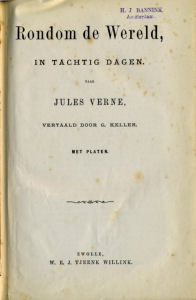

In 1875, Van Santen acquired the translations of the five Verne books published by Tjeenk Willink as well as the rights to the original engravings from Hetzel. At the end of that year, the second edition of Around the world is launched, carrying all 52 original line drawings. Van Santen announces this new edition in a leaflet to the booksellers dated November 1875:
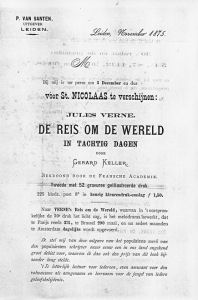
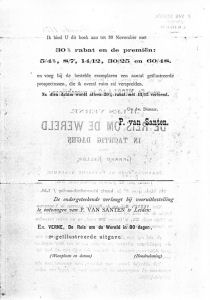
Leaflets were also printed for the distribution to the general public. Logically, on these Van Santen shows off a number of the engravings characterizing the new edition. Five such leaflets have survived, each carrying a different engraving on the front and identical texts on the back, consisting of two favourable book reviews.
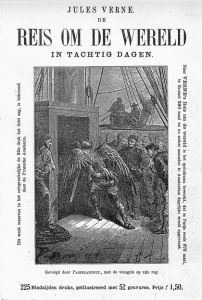
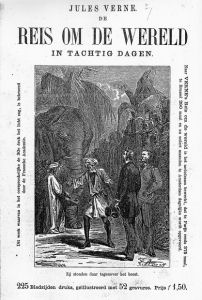
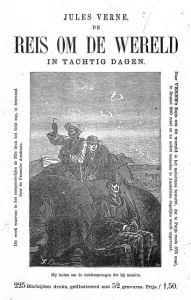
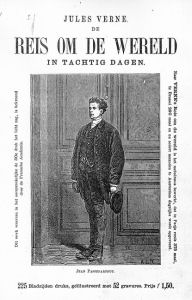
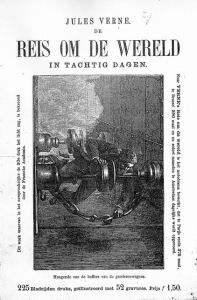
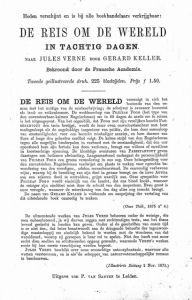
Six months later, in May 1876, Van Santen is back with a new pamphlet plus order form to booksellers, announcing a third edition, as the second edition of 5000 copies was sold out within a few months:
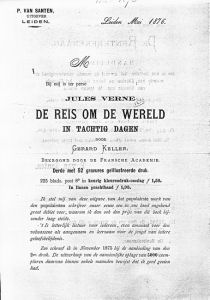

At the end of 1875, Around the world was a popular theme. Not surprisingly, other businessmen also wanted a share of the benefits. Thus, De Grauw published an office and sitting room calendar for the leap year 1876, entitled De reis om de wereld in 366 dagen (Around the world in 366 days), with ten illustrations in four colours from Jules Verne’s book. He placed the following advertisement in the issue of December 10th, 1875 of Het Nieuwsblad voor den Boekhandel (Newspaper for Bookshops):
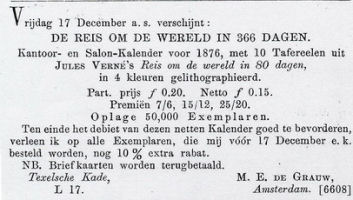
Alas, no copy of this calendar appears to have survived until today.
A further item which appeared was a party game for young folks, derived from Verne’s Around the world, as announced by A. van Hoogstraten & Son in the following advertisements in Het Nieuwsblad voor den Boekhandel in January and October 1876:
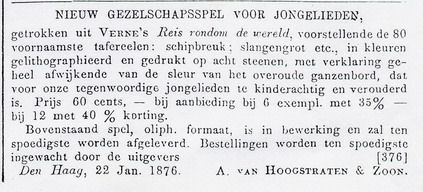
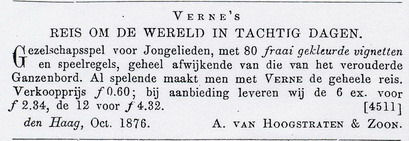
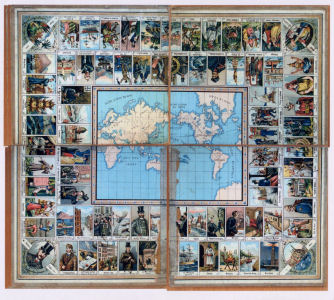
Van Santen (and Gebrs. Koster) also published a black and white game of goose for Around the world. When Van Santen’s books etc. were auctioned off in December 1877, Robbers acquired 2728 copies of this game for 193 guilders.

The latter game was the subject of a paper read by Dr. Paul van den Brink to the Dutch Jules Verne Society in November 2006, entitled: A geographical game of goose and some cartographic notes on the work of Jules Verne.
After selling these copies carrying Van Santen’s name, Robbers published the game under his own name.

An (improved) fourth edition of the book was published by Gebrs. Koster in 1877. It is unclear what the arrangements were between Van Santen and the Koster brothers, as a large part of this edition was used by Van Santen for its fifth edition. Curiously, the title page mentions that it is the 5th edition, but each new section of the book mentions “WERELD, 4e dr”
(“World, 4th edition”
). At the Van Santen auction, Robbers bought a total of 2550 copies of this combined 4th and 5th edition. According to the auction catalogue, 1100 copies were in the form of loose sheets and 60 were bound.

It is not unlikely that the 1100 loose copies were published under Robbers’s own name, with a new title page. The total number of copies of the combined 4th and 5th editions printed is unknown. It is not known how many of these were sold by Koster and by Van Santen themselves before Robbers got hold of them. It is probable that most books of the 4th Koster edition had a simple paper cover as very few have survived to our times.
